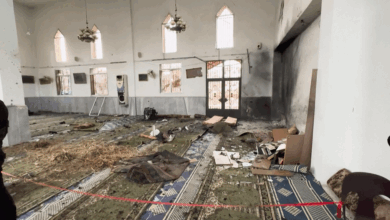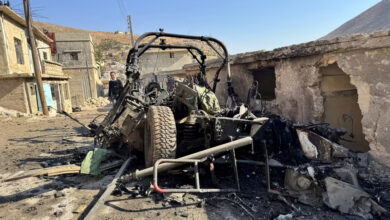
Many have criticized the “hasty” Arabic literature that has emerged in the last 16 months, blossoming in both bookstores and online during the ongoing Arab revolutions.
Young Tunisian novelist Kamel Riahi has argued that literature should not be chained to politics, while celebrated authors Sonallah Ibrahim and Elias Khoury have suggested that it is impossible to create literature about events that are still taking place around us.
And yet there is something about the intersection of literature and real life that compels readers to keep searching for books that resonate with, and expand beautifully on, the current moment — without cheapening either the literature or the moment.
Syrian novelist and TV host Samar Yazbek’s “A Woman in the Crossfire: Diaries of the Syrian Revolution” is one of these rare books.
It was certainly assembled in haste, published in Arabic in 2011 and in English in July 2012. This haste shows in the book’s cracks and edges, its repetitions and omissions. But “A Woman in the Crossfire” is elevated beyond politics or reportage by Yazbek’s intimate style and her willingness to reveal and involve herself in the book.
The book is made up of both testimonies Yazbek gathered and events she experienced during Syria’s first four months of struggle, before she was forced to flee the country. Translator Max Weiss calls these months “the early, heady days” in his afterword. Despite this, “A Woman in the Crossfire” never succumbs to unguarded optimism. Violence is omnipresent, and — though Yazbek argues passionately for a nonsectarian Syria — the threat of civil war lurks everywhere.
Yazbek describes how, from the earliest days, the ruling regime fomented sectarian tension. In the regime’s narrative of events, Sunni protesters — who the regime conflates with Salafis — are inexorably pitted against Alawites and Christians. Yazbek is from the ruling Shia Alawite sect, and she likens the use of her sect to the creation of “human shields” to protect the regime.
But while Yazbek takes a clear and unapologetic stance on Bashar al-Assad’s regime, “A Woman in the Crossfire” is a literary act rather than a political one. Ultimately, the book is not about any particular party or movement, but about freely telling Syria’s stories. It is a stand against all the forces silencing and misrepresenting Syrians.
In what could be seen as a metaphor for the treatment of Syrian protesters, Yazbek tells of a minority Alawite protester who was beaten so much that he could no longer speak. After some struggle, authorities finally took him to a hospital. There he was wheeled around, still unable to speak, while onlookers were told he was a Salafi terrorist and were invited to spit on him.
Weiss writes in the afterword that he would not have “been able to bear the emotional toll of the project without the support of many people.” A similar emotional toll affects the reader. In the book’s most horrible moments, in which humanity is stomped on and brutalized, our brains distance us; we experience these sections as we would fiction. Indeed, Yazbek describes herself as doing the same when she is faced with grave danger and humiliation.
It is instead the smaller moments before which the reader is helpless, such as when an Alawite protester tells Yazbek that a friend came to see him.
“He had been crying. I thought it was because he believed the Alawites had beaten me up for being sectarian. I told him I wished he wouldn’t talk to me like that. It wasn’t the Alawites who beat me up. It was the authorities. Then he clarified that he was actually crying because the ones who beat me up were his cousins,” Yazbek writes.
The account is, for the most part, straightforwardly and plainly told, with occasional leaps into startling, poetic language. But despite these moments, “A Woman in the Crossfire” remains very much a diary rather than a shaped narrative. The book eschews most devices that generally hold a reader’s attention, such as dialogue and rising action. Instead, the reader’s attention is fixed by the need to listen, the urgency of these stories and how much those telling them want to be heard.
Most of the Syrians who give their testimonies to Yazbek are nameless. There are only a few reappearing “characters,” and it is mainly Yazbek and her adolescent daughter who hold the book together.
Yazbek’s daughter, in particular, grabs the reader’s heart. She is furious at her mother for putting them in danger, and “said bitterly that the only way I could make her feel better was to appear on state television and proclaim my loyalty to the president.” Yazbek also fears for her daughter, and describes a night when she wakes up screaming, convinced that her daughter had been kidnapped.
Throughout the book, it is unclear where Syria is headed. But it is clear how Yazbek is changing: “I have somehow become more fragile and stronger at the same time.”
Many people, including Yazbek, risked their lives to bring us this book. “A Woman in the Crossfire” is thus an act of fierce resistance against the forces of silencing and simplification. It is anything but an effortless read, but it does wedge open a space wherein, for a moment, it feels possible to genuinely listen.
This piece was originally published in Egypt Independent's weekly print edition.




